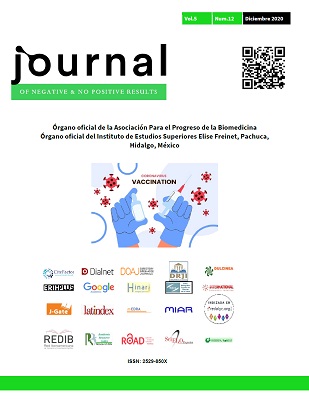Sequels of the pandemic in higher education in Mexico
DOI:
https://doi.org/10.19230/jonnpr.4004Abstract
-
Downloads
References
Shanmugaraj B, Siriwattananon K, Wangkanont K, Phoolcharoen W. Perspectives on monoclonal antibody therapy as pontential therapeutic intervention for Coronavirus disease-19 (COVID-19). Asian Pac J Allergy Immunol. 2020; 38:10-8.
Wang D, Hu B, Hu C, Zhu F, Liu X, Zhang J, et al. Clinical characteristics of 138 hospitalized patients with 2019 novel coronavirus-infected pneumonia in Wuhan, China. JAMA. 2020; 323(11): 1061-9.
Xu Z, Shi L, Wang Y, Zhang J, Huang L, Zhang C, et al. Pathological findings of COVID-19 associated with acute respiratory distress syndrome. Lancet Respir Med. 2020; 2600(20): 19-21.
Ordorika I. Pandemia y educación superior. Revista de la Educación Superior. 2020; 194(49): 1-8.
Lloyd M. Desigualdades educativas en tiempos de la pandemia (Parte 1). Campus Milenio. 2020; 849: 6.
Sieber J. Misconceptions and realities about teaching online. Science and Ethics. 2005; 11: 329-40.
Taft SH, Perkowski T y Martin LS. A Framework for Evaluating Class Size in Online Education. The Quarterly Review of Distance Education. 2011; 12(3): 181-97.
Tomei J. The impact of online learning on faculty load: Computing the ideal class size for online learning. Journal of Technology and Teacher Education. 2006; 14: 531-41.
Published
Issue
Section
License
All accepted originals remain the property of JONNPR. In the event of publication, the authors exclusively transfer their rights of reproduction, distribution, translation and public communication (by any sound, audiovisual or electronic medium or format) of their work. To do so, the authors shall sign a letter transferring these rights when sending the paper via the online manuscript management system.
The articles published in the journal are freely used under the terms of the Creative Commons BY NC SA license, therefore.
You are free to:
Share — copy and redistribute the material in any medium or format
Adapt — remix, transform, and build upon the material
The licensor cannot revoke these freedoms as long as you follow the license terms.
Under the following terms:
Attribution — You must give appropriate credit, provide a link to the license, and indicate if changes were made. You may do so in any reasonable manner, but not in any way that suggests the licensor endorses you or your use.
NonCommercial — You may not use the material for commercial purposes.
ShareAlike — If you remix, transform, or build upon the material, you must distribute your contributions under the same license as the original.
No additional restrictions — You may not apply legal terms or technological measures that legally restrict others from doing anything the license permits.

This work is licensed under a Creative Commons Attribution-NonCommercial-ShareAlike 4.0 International License

























